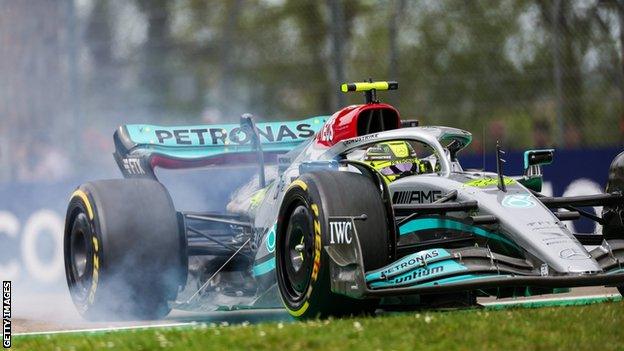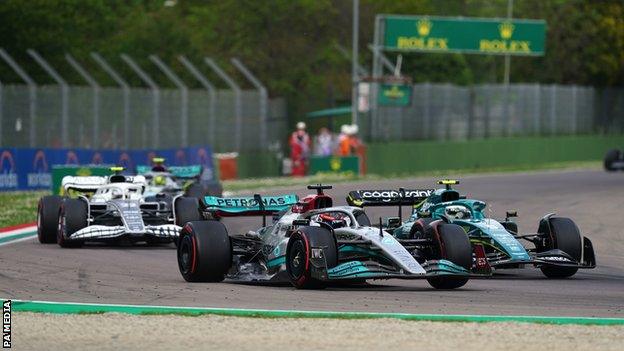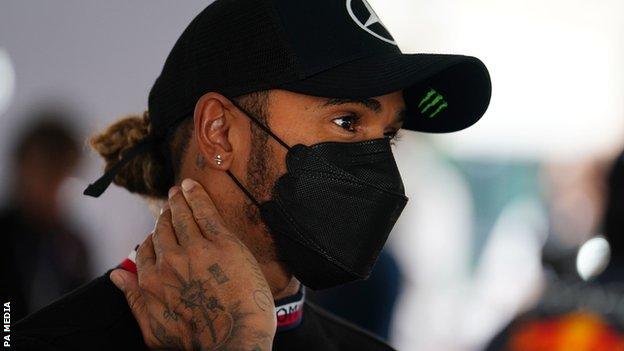Emilia Romagna Grand Prix: Lewis Hamilton says Mercedes 'not fighting for championship'
- Published
- comments

Lewis Hamilton has won at least one grand prix in every season of his Formula 1 career, which began in 2007
Lewis Hamilton wrote off his chances of winning this year's World Championship after a dispiriting performance by his Mercedes team in the sprint race at the Emilia Romagna Grand Prix.
The seven-time champion finished 14th, losing one place from his qualifying position, while team-mate George Russell was 11th, fighting back to where he started after he, too, lost ground at the start.
The 2022 season was already looking difficult for Mercedes after the first three races in which they were nearly a second off the pace of the leading Ferrari and Red Bull cars.
But Imola, as team principal Toto Wolff admitted, "marks the low" of the year so far.
"We stick together," Hamilton said. "We try to motivate everyone. This is the situation we are faced with.
"We are obviously not fighting for the championship. But we are fighting to understand the car and improve and progress through the year. That's all we can hope for right now."
There may still be 20 races to go, but Hamilton said he had to be "realistic" about Mercedes' position.
Why could they not make up ground?

While Red Bull and Ferrari have battled over race and sprint victories so far this season, Mercedes were reduced to fighting in the midfield on Saturday at Imola
The lower half of the field is not where the Mercedes car sits on raw performance - it remains the third fastest in the field.
But after a difficult qualifying session in which the team were compromised by weather and circumstances, it lacked sufficient pace advantage to overtake the cars in front of it.
Both drivers managed to pass an Aston Martin - Russell Sebastian Vettel's and Hamilton Lance Stroll's - but those are the slowest cars in the field. And Russell spent the race behind Mick Schumacher's Haas; Hamilton behind Yuki Tsunoda's Alpha Tauri. Very much not company with which they expected to be familiar before this season started.
Mercedes have had to reset their expectations very quickly, an experience Wolff described as "humbling".
"A lot of work is going on in the background," Hamilton said, "but it is what it is; it's what we have. Ultimately, we haven't got it right this year, but everyone's working as hard as we can to correct it."
The concern for Mercedes right now is that while they know what is wrong with the car - too much drag, not enough grip and terrible aerodynamic bouncing on the straights - they don't know how to fix it.
"We have a direction to unlock the potential in the car to bring us much closer but at the moment we haven't got the key," Wolff said. "So we just need to grind away and rely on the science and physics before spiralling into some kind of negative momentum, which we are not."
The fundamental issue, Mercedes believe, is the bouncing, or porpoising, a problem most teams have to one degree or another, but which is affecting Mercedes more than most.
It is caused by the airflow under the car becoming disrupted and "stalling" as the car lowers as speed increases down the straights. This causes a loss of downforce, which then returns as the car raises, before the problem recurs.
Is the car concept at fault?
Why is this such a problem for Mercedes? Engineers outside the team, both those with previous experience of ground-effect cars from the late 1970s and early 1980s, and those in rival teams now, believe the cause is the car's floor.
Any flexibility in the floor of a car of this design can be very disruptive, and the Mercedes has a very different design philosophy from that of Ferrari and Red Bull, with vast exposed areas of floor.
This is a continuation of a philosophy Mercedes followed with great success in recent years, and great effort was made to take it to extremes this season. The result was a car with virtually no sidepods - bodywork beside the driver.
This should reduce drag and enhance aerodynamics. But it seems to have caused problems with floor rigidity - something of crucial importance under the new rules introduced this year, which have greatly increased the proportion of overall downforce created under the car.
Mercedes now admit that they fear the unusual concept of the car could be the cause of the problem.
"It is a valid point," Wolff said. "All of the goodness and badness happens mainly on the floor and we have interesting ideas and concepts that we are exploring that have to find their way onto the car in the next few races.
"I wouldn't say there is such thing as a concept being wrong. But is there a part of what we have done that simply doesn't work with the regulations, and what is it?
"You don't need to throw away the goodness, but if there are fundamental areas that don't allow us to unlock the potential that we believe is in the car, then you need to cut your losses."
Hamilton said: "It's all questions that are reasonable. I can't say whether the concept is flawed; I am not an aerodynamicist. At some stage we will have a better understanding of whether that is the case or not.
"Maybe all of a sudden we will fix the bouncing and unlock more potential. It is difficult it write it off. Hopefully it will come to light soon and then we can start putting our focus on to the solution because we haven't found the solution yet."
Abandoning this design, though, would mean an admission that all their research before this year was flawed - and raise wider, deeper questions.
"It would mean you say, 'Where is the baseline now?'" Wolff said. "Is there a new one we can start on where we believe we can unlock more potential?
"(But) if we thought that, we would have done it five months ago. We believed this was the development line we needed to take. So it is quite a tricky exercise.
"You can only cut the losses into next year if you understand where we got it wrong, because at the moment we simply don't. Not yet."
How is Hamilton coping?

Hamilton has helped lead Mercedes to eight consecutive constructors' championship wins from 2014-2021
In his news conference after qualifying, Hamilton wryly reminded the media of a comment he had made pre-season, before the car had run.
"Earlier in the year," he said, "a question was put to me: 'What happens if you get it wrong?' I said: 'We don't do that. We don't get things wrong.' But the fact is we may have."
It was a public admission that hubris is a dangerous characteristic to fall into for anyone, even a seven-time world champion.
Mercedes' plight has returned Hamilton to a situation with which he has not been familiar for more than a decade.
Not since 2009 has he driven a car this uncompetitive - and back then he was a hungry one-time world champion with so much more to achieve. Now, he is the most successful driver in the history of the sport, and will be 38 next year.
But he says his determination to fight on and return to competitiveness is undiminished.
And he dismissed suggestions he may not want to continue in this scenario as "silly and a bunch of nonsense" from "individuals that I respected when I was younger (with) the aim of getting headlines to keep themselves relevant".
"I am 100% committed to this team," Hamilton said. "There is nowhere else I want to be, just because we have hit a rough patch, it is not in my DNA to back out. We can fix this. It is going to be a painful year that we are going to have to ride out together.
"We just have to work hard to make sure we are not in this position next year."

House of Maxwell: The story of one of the most extraordinary family sagas the world has ever seen
'A band of oddities, gentlemen and pirates': Your first look at the exciting new drama SAS Rogue Heroes from the creator of Peaky Blinders

